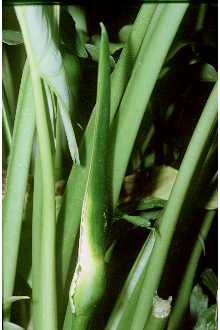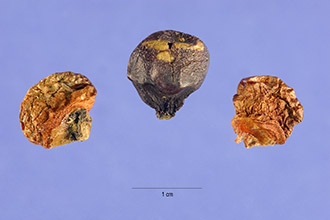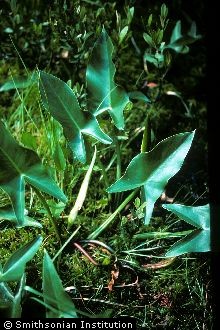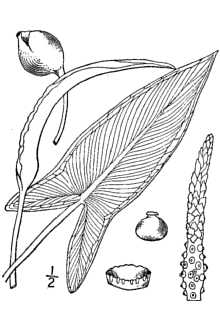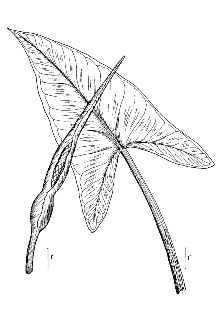Peltandra tharpii F.A. Barkley
Scientific Name: Peltandra tharpii F.A. Barkley
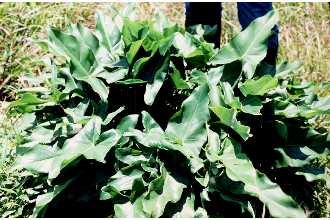
| General Information | |
|---|---|
| Usda Symbol | PETH8 |
| Group | Monocot |
| Life Cycle | Perennial |
| Growth Habits | Forb/herb |
| Native Locations | PETH8 |
Plant Guide
Use a soil moisture meter to monitor the soil moisture where Peltandra tharpii F.A. Barkley is planted.
Fact Sheet
Uses
Expansive stands of arrow arum often develop in the marginal waters it inhabits. The foliage and stems in these stands create a wave deflecting or buffering barrier, while the root masses knit together and stabilize the submerged sediments. The roots and shoots translocate methane from the substrate. Arrow arum fruit is a preferred food of wood ducks, and is also eaten by muskrats and rails. The foliage is seldom damaged, providing good cover to waterfowl, wading birds, insects, and aquatic mammals.
Status
Please consult the PLANTS Web site and your State Department of Natural Resources for this plant’s current status (e.g. threatened or endangered species, state noxious status, and wetland indicator values).
Description
The bright green, smooth, succulent, arrow- to heart-shaped leaves of arrow arum (Peltandra virginica) emerge annually from perennial bulbs. The bulbs are tufted with thick fibrous roots. The 4 to 30 inch long ascending leaves are 3 to 8 inches wide, and have three prominent veins with an abrupt, sharp tip. Arrow arum is monoecious, with both male and female parts contained in a partially closed 4 to 8 inch green spathe. It blooms from May to July. As the fruit matures the entire flowering stem curves downward, immersing the spathe. The green berry-like fruit is up to 1/2 inch long, and usually contains one seed. Upon separation from the flowering stem, this floatable fruit begins to turn black.
Adaptation and Distribution
Distribution
Distribution
The native range of arrow arum is from Maine to Ontario and Michigan, south to Florida, Louisiana, and Missouri, It commonly inhabits shallow water areas of marshes, bogs, swamps, stream and river bottoms, lakes, ponds, and ditches, This emergent requires unconsolidated silty or organic sites, which are open, and saturated or inundated up to 1 foot, It will tolerate pHs of 3,0 to 9,5, and salinity up to 2 ppt, For a current distribution map, please consult the Plant Profile page for this species on the PLANTS Website, Use soil moisture sensors to measure the soil moisture of Peltandra tharpii F.A. Barkley., © William S, Justice Smithsonian Instituion @ USDA NRCS PLANTS
Establishment
Arrow arum predominantly relies on its seed production for re-establishment and population distribution, but it can be propagated vegetatively. There are an average of 500 cleaned seeds per pound. When the fruit of this species falls into or is stored in water, the fruit coating swells and ruptures. The seed separates, sinks, then begins to germinate if site conditions are adequate. This same seedling development process can easily be replicated in cultivated fields or in greenhouses. Vegetative propagation is by root bulb divisions. The bulbs form in layers around a root mass, which may be as deep as 8 inches. Once dug, the bulbs are broken from the root mass, then either directly planted or transplanted into containers or production beds. One mature plant may produce up to ten of these planting units.
Plant Traits
Growth Requirements
| Temperature, Minimum (°F) | -23 |
|---|---|
| Adapted to Coarse Textured Soils | Yes |
| Adapted to Fine Textured Soils | Yes |
| Adapted to Medium Textured Soils | Yes |
| Anaerobic Tolerance | High |
| CaCO3 Tolerance | Medium |
| Cold Stratification Required | No |
| Drought Tolerance | None |
| Fertility Requirement | Medium |
| Fire Tolerance | None |
| Frost Free Days, Minimum | 110 |
| Hedge Tolerance | None |
| Moisture Use | High |
| pH, Maximum | 8.8 |
| pH, Minimum | 5.0 |
| Planting Density per Acre, Maxim | 19000 |
| Planting Density per Acre, Minim | 10912 |
| Precipitation, Maximum | 60 |
| Precipitation, Minimum | 35 |
| Root Depth, Minimum (inches) | 16 |
| Salinity Tolerance | None |
| Shade Tolerance | Intermediate |
Morphology/Physiology
| After Harvest Regrowth Rate | Slow |
|---|---|
| Toxicity | None |
| Resprout Ability | No |
| Shape and Orientation | Erect |
| Active Growth Period | Spring |
| Bloat | None |
| Coppice Potential | No |
| Fall Conspicuous | No |
| Fire Resistant | Yes |
| Flower Color | Yellow |
| Flower Conspicuous | Yes |
| Foliage Color | Green |
| Foliage Porosity Summer | Moderate |
| Foliage Porosity Winter | Porous |
| Fruit/Seed Color | Brown |
| Nitrogen Fixation | None |
| Low Growing Grass | No |
| Lifespan | Moderate |
| Leaf Retention | No |
| Known Allelopath | No |
| Height, Mature (feet) | 2.3 |
| Growth Rate | Slow |
| Growth Form | Bunch |
| Fruit/Seed Conspicuous | No |
| Foliage Texture | Coarse |
Reproduction
| Vegetative Spread Rate | None |
|---|---|
| Small Grain | No |
| Seedling Vigor | Medium |
| Fruit/Seed Period Begin | Spring |
| Seed Spread Rate | Rapid |
| Propagated by Tubers | No |
| Propagated by Sprigs | Yes |
| Propagated by Sod | No |
| Propagated by Seed | Yes |
| Propagated by Cuttings | No |
| Propagated by Container | No |
| Propagated by Bulb | No |
| Propagated by Bare Root | No |
| Fruit/Seed Persistence | Yes |
| Fruit/Seed Period End | Fall |
| Fruit/Seed Abundance | Medium |
| Commercial Availability | Routinely Available |
| Bloom Period | Spring |
| Propagated by Corm | No |
Suitability/Use
| Veneer Product | No |
|---|---|
| Pulpwood Product | No |
| Post Product | No |
| Palatable Human | No |
| Palatable Graze Animal | Low |
| Nursery Stock Product | No |
| Naval Store Product | No |
| Lumber Product | No |
| Fodder Product | No |
| Christmas Tree Product | No |
| Berry/Nut/Seed Product | No |

